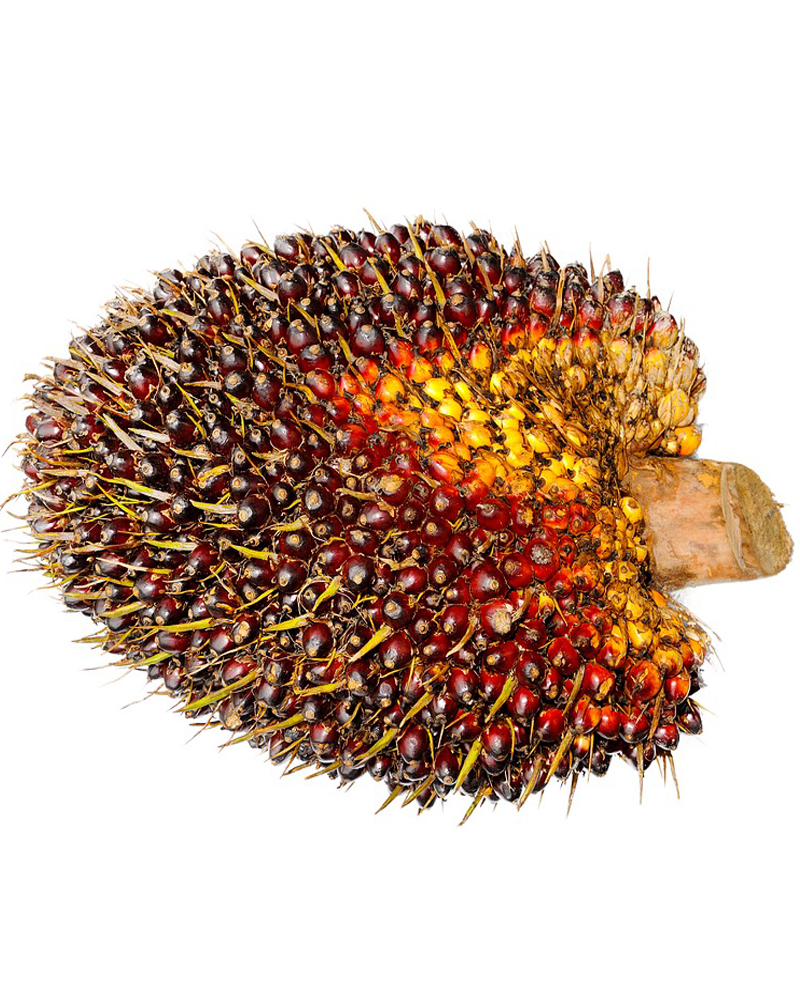
Palm oil is also known as palm fruit oil. Palm oil is said to be nature’s gift to the world. Consumed for more than 5,000 years, its nutritional value, health benefits and value as a natural resource continue to be discovered even today.Palm oil is produced from the fruit of the oil palm tree Elaeis guineensis. Oil palm is the only fruit that can give two types of oil. Since it is a vegetable oil; not an animal or dairy product, and therefore does not contain cholesterol.
Palm oil is sometimes confused with palm kernel oil, but in fact it is quite different compositionally. Palm oil comes from the mesocarp (flesh of the fruit) and the lauric palm kernel oil from the kernel at the fruit’s core. The two oils are separated in the oil palm bunches by the thick shell of palm kernels. Palm oil is physically refined without the use of chemical solvents, thereby reducing the risk of residue contamination.
Palm oil itself is reddish because it contains a high amount of betacarotene. It is used as cooking oil, to make margarine and is a component of many processed foods. Boiling it for a few minutes destroys the carotenoids and the oil becomes white. Palm oil is one of the few vegetable oils relatively high in saturated fats (such as coconut oil) and thus semi-solid at room temperature.
Previously the second-most widely produced edible oil, after soybean oil, 28 million metric tons were produced worldwide in 2004. It may have now surpassed soybean oil as the most widely produced vegetable oil in the world. Since its introduction, oil palm is now a leading agricultural crop. Increased planting, cultivation and refinement have led to the introduction of a wide range of processed palm oil products. Today, palm fruit oil and palm oil products are used in many food and non-food applications. They can be used for frying media and for making margarines, shortenings, soap, oleo chemicals and other products.
പാം ഓയിലിനെ പാം ഫ്രൂട്ട് ഓയിൽ എന്നും പറയാറുണ്ട്. പ്രകൃതി ലോകത്തിനു നൽകിയ വരധാനമായിട്ടാണ് ഇതിനെ കണക്കാക്കുന്നത്. ഇതിന്റെ പോഷക ഗുണങ്ങൾ, ആരോഗ്യ ഗുണങ്ങൾ, പ്രകൃതിയിൽ നിന്ന് ലഭിക്കുന്നത് തുടങ്ങിയ പ്രത്യേകതകൾ ഉള്ളതുകൊണ്ട് 5,000 വർഷങ്ങൾക്ക് മുമ്പ് കണ്ടെത്തിയത് ഇന്നും നില നിന്നു പോകുന്നു. Elaeis guineensis എന്ന മരത്തിന്റെ പഴത്തിൽ നിന്നാണ് പാം ഓയിൽ ഉൽപ്പാദിപ്പിക്കുന്നത്, ഈ പഴത്തിന് മാത്രമേ രണ്ട് തരത്തിലുള്ള എണ്ണ നൽകുവാൻ കഴിയൂ. ഇത് ഒരു സസ്യ എണ്ണ ആയതിനാലും, മൃഗങ്ങളുടെ കൊഴുപ്പിൽ നിന്നോ, ക്ഷീരോൽപ്പനങ്ങളിൽ നിന്നോ ഉൽപ്പാദിപ്പിക്കാത്തതിനാലും ഇതിൽ കൊളസ്ട്രോൾ അടങ്ങിയിട്ടില്ല.
പാം ഓയിലും കെർണൽ ഓയിലും രണ്ടും ഉൽപ്പാദന രീതികൊണ്ട് വ്യത്യസ്ഥമാണ്. എണ്ണപ്പന കായ്കളുടെ മാംസളമായ ഭാഗത്തു നിന്നാണ് പാം ഓയിൽ ലഭിക്കുന്നത്, ലോറിക് പാം കെർണൽ ഓയിൽ ലഭിക്കുന്നത് പഴത്തിന്റെ ആഗ്ര ഭാഗത്തു നിന്നും, ഇവയെ രണ്ടിനെയും തമ്മിൽ വേർതിരിക്കുന്നത് പാം കെർണലിലെ കട്ടി കൂടിയ ഷെൽ ആണ്. കെമിക്കൽ ലായകം ഒന്നും ചേർക്കാതെ ശുദ്ധീകരിച്ചെടുത്ത എണ്ണയാണ് പാം ഓയിൽ അതുകൊണ്ട് തന്നെ ഇത് അപകട സാധ്യത കുറയ്ക്കുന്നു.
പാം ഓയിലിന്റെ നിറം ചുവപ്പാണ്, കാരണമെന്തെന്നാൽ ഇതിൽ ബീറ്റാകരോട്ടീൻറെ അളവ് കൂടുതലാണ്. പാചകത്തിനുള്ള എണ്ണയായിട്ടാണ് ഇതിനെ കൂടുതലും ഉപയോഗിക്കുന്നത്. ഈ എണ്ണയെ കുറച്ചു നിമിഷം ചൂടാക്കിയാൽ അതിലെ കരോട്ടിനോയിഡ്സ് എല്ലാം നശിച്ചു വെള്ള നിറമായി മാറും. സസ്യ എണ്ണകളിൽ പാം ഓയിൽ മാത്രമാണ് കൂടിയ അളവിൽ പൂരിതമായാ കൊഴുപ്പ് അടങ്ങിയതും (വെളിച്ചെണ്ണ പോലെ) അന്തരീക്ഷ താപനിലയിൽ അർദ്ധഖരാവസ്ഥയിൽ ആകുന്നതും.
സോയാബീൻ ഓയിലിനു ശേഷം ലോകത്തിൽ ഏറ്റവും കൂടുതൽ ഉൽപ്പാദിപ്പിക്കുന്നത് പാം ഓയിലാണ്. 2004-ൽ 20 മില്യൺ മെട്രിക് ടൺസ് ആണ് ഉൽപ്പാദിപ്പിച്ചത്. എണ്ണപ്പന ഇപ്പോൾ ഒരു പ്രധാന കാർഷിക വിളയായി മാറിയിരിക്കുന്നു, ഇതിന്റെ
കൃഷിയും, ഉൽപ്പാദനവും, വിപണനവും വർദ്ധിച്ചുകൊണ്ടിരിക്കുന്നു. പല ഭക്ഷണ പദാർത്ഥങ്ങളിലും മറ്റ് ഉപകരണങ്ങളിലും പാം ഓയിലിന്റെ ഉപയോഗം നാൾക്ക് നാൾ വർദ്ധിച്ചു വന്നുകൊണ്ടിരിക്കുന്നു.
PALM OIL CHEMICAL COMPOSITION-PALM KERNEL-OLEIN
Palm kernel oil is obtained from the kernel of the oil palm fruit. The oil composition is very different from that of the palm oil. Palm kernel oil contains 48.2% Lauric acid, 16.2% Myristic acid, 8.4% palmitic, 3.4% Capric, 3.3% Caprylic, 2.5% Stearic (saturated fatty acid), 15.3% Oleic (monounsaturated fatty acid), 2.3% Linoleic (polyunsaturated fatty acid), and 0.4% other acids
The approximate concentration of fatty acids (FAs) in palm kernel oil is as follows:
| Fatty acid content of palm kernel oil | ||
| Type of fatty acid | Percent | |
| Lauric C12 |
 |
48.2% |
| Myristic C14 |
 |
16.2% |
| Palmitic C16 |
 |
8.4% |
| Capric C10 |
 |
3.4% |
| Caprylic C8 |
 |
3.3% |
| Stearic C18 |
 |
2.5% |
| Oleic C18 |
 |
15.3% |
| Linoleic C18 |
 |
2.3% |
| Others |
 |
0.4% |
|
green: Saturated blue : Mono unsaturated orange: Poly unsaturated |
||

